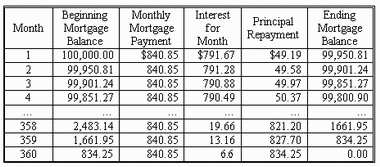Do you want BuboFlash to help you learning these things? Or do you want to add or correct something? Click here to log in or create user.
Subject 3. Residential Mortgage Loans
#basic-concepts #cfa #cfa-level-1 #fixed-income #has-images #reading-55-introduction-to-asset-backed-securities
A mortgage is a loan secured by the collateral of a specified real estate property. It obligates the borrower to make a predetermined series of payments. If the borrower fails to make the contracted payments, the lender can seize the property in order to ensure that the debt is paid off.

The interest rate on a mortgage loan is called the mortgage rate or contract rate. The ratio of the property's purchase price to the amount of the mortgage is called the loan-to-value ratio.
The basic idea behind the design of the fixed-rate, level-payment, fully amortized mortgage loan is that the borrower pays interest and repays principal in equal installments over an agreed-upon period of time, called the maturity or term of the mortgage. Thus at the end of the term the loan has been fully amortized.
Each monthly payment for this mortgage design is due on the first of each month and consists of:
- Interest of 1/12 of the fixed annual interest rate multiplied by the amount of the outstanding mortgage balance at the beginning of the previous month
- A repayment of a portion of the outstanding mortgage balance (principal)
The difference between the monthly mortgage payment and the portion of the payment that represents interest equals the amount that is applied to reduce the outstanding mortgage balance. Early payments are mostly interest with a small amount of principal repayment, while later payments are mostly principal repayment with a small amount of interest.
The following table illustrates the annual breakdown of a 30-year (360 month) mortgage on a $100k loan that yields 9.5% interest.

As the example shows, the portion of the monthly mortgage payment applied to interest declineseach month, and the portion applied to principal repayment increases.
The various mortgage designs throughout the world specify:
- The maturity of the loan
- How the interest rate is determined (fixed rate, variable rate or hybrid rate)
- How the principal is repaid (i.e., whether the loan is amortizing or not, whether it is fully amortizing or partially amortizing with a balloon payment)
- Whether the borrower has the prepayment option and whether there are any prepayment penalties
- The rights of the lender in a foreclosure (whether the loan is a recourse or non-recourse loan)
Prepayments and Cash Flow Uncertainty
Mortgage borrowers may have an embedded option that allows them to prepay all or part of their loan at anytime during the life of the mortgage. Prepayments occur for one of several reasons:
- Homeowners prepay the entire mortgage when selling their home.
- Refinancing when market rates fall below the contract rate.
- In the case of homeowners who cannot meet their mortgage obligations, the property is repossessed and sold, and the proceeds are used to pay off the mortgage.
- If property is destroyed by fire or another insured catastrophe occurs, insurance proceeds are used to pay off the mortgage.
The prepayment could be the entire outstanding balance or a partial paydown of the mortgage balance. When a prepayment does not cover the entire outstanding balance it is called a curtailment.
Thus, lenders do not know with certainty what their cash flows (both the amount and timing) will be for any given period. This risk is referred to as prepayment risk. Usually, mortgages are prepaid when interest rates fall. Hence, lenders receive repayment at a time when they cannot reinvest the cash at the same high rate at which they had originally invested.
Mortgages with prepayment penalties originated in 1996 to deter prepayment. In this structure, there is a period of time during which, if the loan is prepaid in full or in excess of a certain amount of the outstanding balance, there is a prepayment penalty. This period is referred to as the lockout period or penalty period.
If you want to change selection, open original toplevel document below and click on "Move attachment"
Summary
| status | not read | reprioritisations | ||
|---|---|---|---|---|
| last reprioritisation on | suggested re-reading day | |||
| started reading on | finished reading on |
Details
Discussion
Do you want to join discussion? Click here to log in or create user.